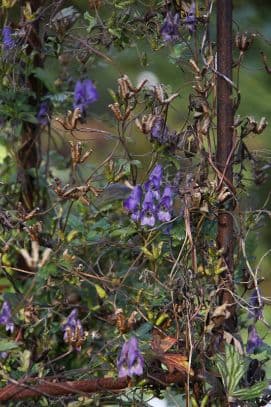Transylvanian Liverwort Hepatica transsilvanica

ABOUT
The plant commonly known as the Transylvanian liverleaf or Transylvanian hepatica is characterized by its charming and ornamental appearance. It displays an enchanting array of flowers, which bloom in shades of blue, violet, pink, or sometimes white. Each flower typically consists of six to ten petal-like sepals, which may be mistaken for petals. These flowers emanate from delicate stems that unfurl from the base of the plant, standing as remarkable focal points against the foliage. The leaves of the Transylvanian liverleaf are unique and easily identifiable. They are leathery in texture and remain through winter, displaying a deep green color. The leaves are divided into three lobes that may remind one of a liver, hence the common name 'liverleaf'. An interesting aspect of these leaves is their capacity to change color during cold weather; they can often take on purplish or bronzy tones. Beneath the visible parts of the plant, a system of rhizomes allows the Transylvanian liverleaf to propagate and create clusters that cover the ground. Overall, the plant has an enchanting and delicate appearance that is appreciated by gardeners and plant enthusiasts who seek to add a touch of natural beauty to shaded or woodland garden settings.
About this plant
 Names
NamesFamily
Ranunculaceae
Synonyms
Transylvanian Liverleaf, Blue Anemone
Common names
Anemone transsilvanica, Hepatica nobilis var. transsilvanica.
 Toxicity
ToxicityTo humans
The common name of Hepatica transsilvanica is Transylvanian Liverleaf. Based on current knowledge, this plant is not commonly known for its toxicity to humans. There is limited information regarding severe reactions or toxicity from ingestion of Transylvanian Liverleaf. However, as with many plants, it is always prudent to exercise caution and avoid ingesting parts of unknown plants due to potential individual sensitivities or undocumented effects.
To pets
The common name of Hepatica transsilvanica is Transylvanian Liverleaf. There is limited information available on the toxicity of Transylvanian Liverleaf to pets. While it is not widely recognized as a poisonous plant for animals, pets should not be allowed to ingest plants that are not proven to be safe. If a pet does ingest some of the plant, it is wise to monitor them for any unusual symptoms and consult a veterinarian if any concerns arise.
 Characteristics
CharacteristicsLife cycle
Perennials
Foliage type
Evergreen
Color of leaves
Green
Flower color
Blue
Height
4-6 inches (10-15 cm)
Spread
6-8 inches (15-20 cm)
Plant type
Herb
Hardiness zones
4
Native area
Romania
Benefits
 General Benefits
General Benefits- Erosion Control: The plant's root system helps in stabilizing soil and preventing erosion.
- Habitat for Wildlife: Offers food and shelter for various insects and animals.
- Aesthetic Appeal: Adds beauty to gardens and natural landscapes with its colorful flowers.
- Early Spring Bloomer: One of the first plants to bloom in spring, indicating the change of seasons.
- Drought Tolerance: Once established, it can tolerate periods without water, reducing the need for irrigation.
- Cold Tolerance: Can survive in cold temperatures, making it suitable for temperate climates.
- Low Maintenance: Requires minimal care once established, making it ideal for low-maintenance gardens.
 Medical Properties
Medical PropertiesThis plant is not used for medical purposes.
 Air-purifying Qualities
Air-purifying QualitiesThis plant is not specifically known for air purifying qualities.
 Other Uses
Other Uses- Hepatica is often used in garden design for early spring color, as it blooms with delicate flowers often before other plants have started to sprout.
- The plant can be used for educational purposes such as botanical studies due to its characteristic three-lobed leaves and diversity within the genus.
- Hepatica can be a source of inspiration for artists and photographers, especially during its blooming season in early spring.
- This plant is sometimes used in butterfly gardens, as it provides nectar for early-season butterflies and other pollinators.
- Eco-friendly landscaping may incorporate Hepatica to reduce lawn space, thereby lowering water usage and maintenance.
- In some regions, Hepatica is used in shade gardens due to its tolerance of low-light conditions under trees and shrubs.
- The leaves of the Hepatica, which remain green throughout the winter, are valued for adding visual interest in winter gardens or landscapes.
- Folklore and mythology enthusiasts might utilize Hepatica in rituals or gardens due to its historical association with liver ailments and its symbolic representation of the liver, though this is not related to its efficacy as a medicinal plant.
- Hepatica is occasionally used in culinary decoration, although it is not eaten, to add a splash of color to dishes with its bright flowers.
- Crafters sometimes use dried Hepatica flowers to make natural jewelry or incorporate them into paper making for textured designs.
Interesting Facts
 Feng Shui
Feng ShuiHepatica is not used in Feng Shui practice.
 Zodiac Sign Compitability
Zodiac Sign CompitabilityHepatica is not used in astrology practice.
 Plant Symbolism
Plant Symbolism- Resilience and Tenacity: The Hepatica transsilvanica, often referred to simply as Hepatica, is known for its resilience and ability to survive in challenging climates. This represents the human qualities of persistence and determination.
- Hope and Renewal: Blooming early in spring, the Hepatica is one of the first flowers to emerge after winter, symbolizing hope and the renewal that comes with a new season.
- Protection: In some traditions, Hepatica is believed to ward off negative energies and offer protection due to its early blooming, which can be seen as a sign of strength.
- Admiration and Beauty: Hepatica flowers are admired for their delicate beauty, which can symbolize the appreciation for subtle beauty and finesse in life.
 Water
WaterFor the Transylvanian Liverwort, ensure that the soil is kept moist but not waterlogged by checking at least once a week. During the growth season in spring and fall, you may need to water it once every 5 to 7 days, using roughly 8 to 12 ounces of water each time, depending on the size of your plant and the dryness of the soil. In the winter, reduce watering to once every 10 to 14 days, as the plant requires less moisture when dormant. Be cautious to not overwater, as this can lead to root rot.
 Light
LightThe Transylvanian Liverwort thrives best in partial shade, mimicking its natural woodland habitat. It should be placed in a spot where it receives dappled sunlight or light shade throughout the day. Avoid direct, intense sunlight, especially during the hottest parts of the day, as this can scorch the leaves and stress the plant.
 Temperature
TemperatureThe Transylvanian Liverwort prefers cooler temperatures and can typically withstand temperatures down to about 20 degrees Fahrenheit but should not be exposed to prolonged periods of extreme cold. The ideal temperature range for this plant is between 50 and 70 degrees Fahrenheit. It's important to protect the plant from harsh winter winds and excessively hot temperatures.
 Pruning
PruningPruning the Transylvanian Liverwort is mostly for removing dead or damaged foliage to keep the plant healthy and encourage new growth. It is best to prune in the late winter or early spring before new growth begins. Cut away only the damaged leaves and spent flowers, doing so once a year or as needed to maintain a tidy appearance.
 Cleaning
CleaningAs needed
 Soil
SoilThe best soil mix for Hepatica, commonly known as Transylvanian Liverleaf, should be rich, well-draining, and have a high content of organic matter, like leaf mold or compost. The soil pH should be slightly acidic to neutral, ranging from 6.0 to 7.0, to mimic its natural woodland habitat conditions.
 Repotting
RepottingTransylvanian Liverleaf does not require frequent repotting and can thrive in the same container for several years. It is generally recommended to repot this plant only when it has outgrown its current pot or the soil has degraded, typically every 3 to 5 years.
 Humidity & Misting
Humidity & MistingTransylvanian Liverleaf prefers a humid environment that simulates its natural woodland habitat. Aim to maintain humidity levels around 50% to 60% for optimal growth.
 Suitable locations
Suitable locationsIndoor
Provide dappled shade and keep soil moist for Liverleaf indoors.
Outdoor
Plant in partial shade and moist, rich soil for Liverleaf outdoors.
Hardiness zone
4-8 USDA
 Life cycle
Life cycleThe life of the Caucasian liverleaf (Hepatica transsilvanica) begins with seed dispersal, often facilitated by ants or gravity. Upon finding suitable soil, the seed germinates, typically requiring a period of cold stratification to break dormancy. The seedling then emerges, developing its first true leaves which are often three-lobed, resembling the mature foliage. The plant grows slowly, forming a basal rosette, and may take several years to reach flowering maturity. Once mature, the Caucasian liverleaf blooms early in the spring, with flowers of varying colors, most commonly blue or violet, but sometimes white or pink, before the canopy trees leaf out. Following pollination, often by early-season insects, the plant sets seeds and the cycle repeats.
 Propogation
PropogationPropogation time
Spring
For the Hepatica transsilvanica, commonly known as the Transylvanian Liverleaf, the most popular method of propagation is by seed. The best time for sowing seeds is in late fall or early winter, as this allows for a period of natural cold stratification which is necessary for germination. Sowers should scatter the seeds onto a well-draining soil mix, lightly covering them with soil. Since the germination rate can be low and erratic, patience is key. Once seedlings establish themselves and produce a set of true leaves, they can be gently transplanted to their final growing location in semi-shaded conditions resembling their native woodland habitats.








![Baneberry [Misty Blue]](/_next/image?url=https%3A%2F%2Fplants-admin.emdemapps.com%2Fimages%2Fplants%2F%2Fimages%2F604b5cb1d04e1.png&w=640&q=75)
